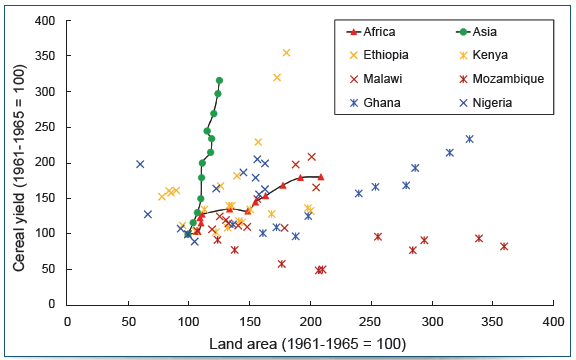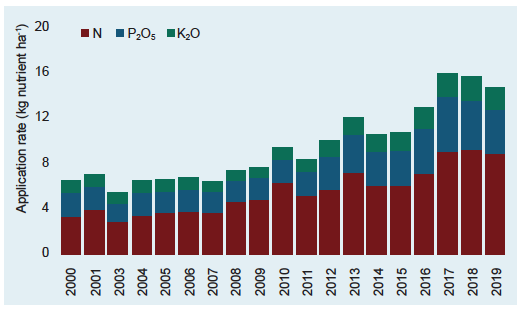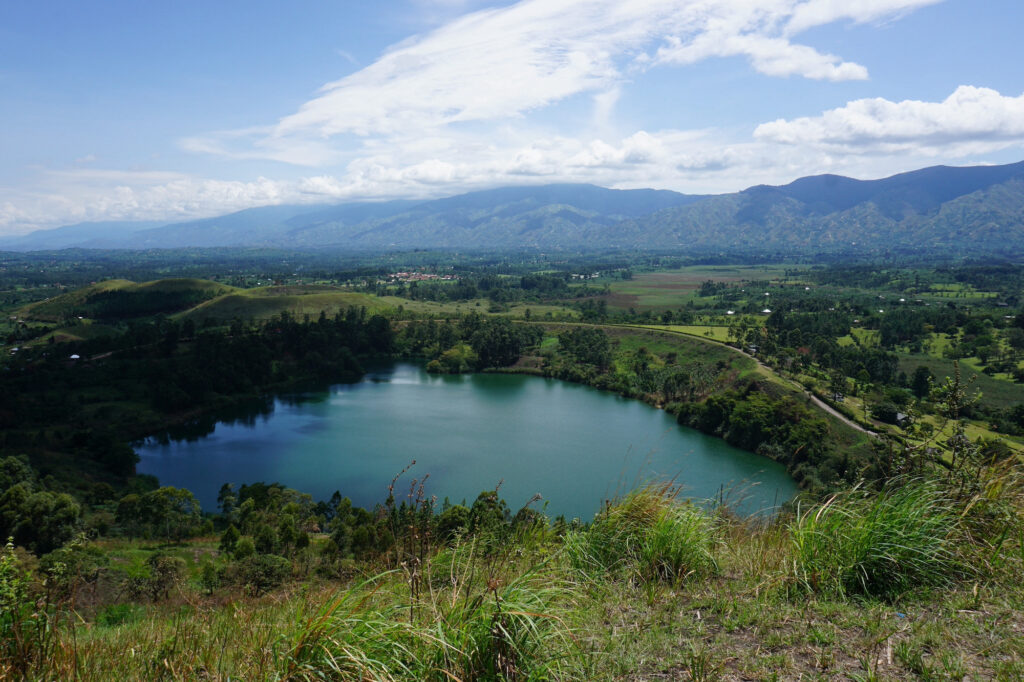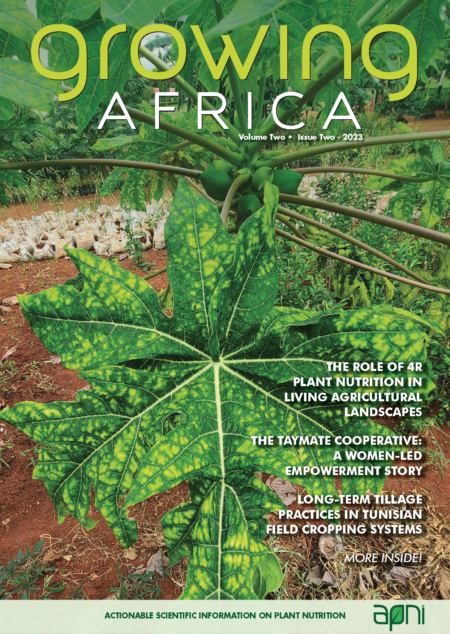By Achim Dobermann
The balanced and efficient use of fertilizers is critical for improving food security, reducing malnutrition and protecting biodiversity in Africa. The next Africa Fertilizer Summit must result in concrete targets, commitments and actions by governments and industry to, within the next 10-20 years, at least triple the nutrient input rates on cropland. Otherwise hunger and malnutrition will persist, and more natural ecosystems will be destroyed.
In the 1960s, yields of cereals and other staple crops were similar in sub-Saharan Africa (SSA) and Asia. Since then, crop yields in most African countries have risen, albeit far slower than compared to Asia or other world regions, causing the land area under cultivation to more than double in size (Fig. 1). But we also observe that African countries that have made stronger efforts to increase fertilizer use (e.g., Ethiopia) have also been more successful in raising crop yields (Fig. 1).

Over 100 million (M) ha of grasslands, savannahs and forests have been converted to cropland in Africa since the early 1960s. Between 2010 and 2022, Africa had the largest annual rate of net forest loss of 3.9 M ha yr-1, much of that due to shifting cultivation (FAO, 2020). Hence, besides general concerns about food security and malnutrition, cropland expansion due to low-input, low-yield agriculture also leads to massive biodiversity loss due to habitat destruction, soil degradation or siltation of waters, and it increases human conflicts (IBPES, 2018; Scientific Panel on Responsible Plant Nutrition, 2021). Overexploitation and land degradation could result in the loss of 50% of Africa’s bird and mammal species, and 20-30% of lake productivity by the end of the century (IBPES, 2018). Besides destroying biodiversity, matching the future food demand in Africa through more conversion of forests and grasslands to arable crops would also result in much higher greenhouse gas emissions than if crop production was intensified on existing land (van Loon et al., 2019). Hence, protecting natural ecosystems is now a top priority for the continent and agriculture should become one of the most important means of achieving it.
But this requires a different kind of agriculture than what prevails today. In the 1980s, annual nutrient losses in SSA were estimated at 22 kg N, 2.5 kg P, and 15 kg K ha-1 of arable land, and losses were up to double that in East Africa (Stoorvogel et al., 1993). Although fertilizer use has increased somewhat since then (Fig. 2), crop yields have increased too. Hence, for the continent as a whole, nutrient input-output balances have not improved at all, resulting in persistent nutrient deficits and soil nutrient depletion that must be overcome to improve food security and environmental sustainability within the next few decades (van Ittersum et al., 2016; Berge et al., 2019). Of course, continental or national averages mask a huge amount of variation. At the continental scale, such data are somewhat skewed by a few countries with relatively high fertilizer consumption, for example Egypt. Despite the lack of reliable information at national and sub-national scales, data on current rates of fertilizer application suggest wide variation among crops and farmers.
The widespread and unsustainable levels of plant nutrient deficits in many parts of SSA, and consequent destruction of natural ecosystems, has been known for a very long time. Critical questions arise: (i) why then has nobody done more about it? and (ii) why is it that we seem to even stagnate in our efforts to overcome that?
In 2006, the first Africa Fertilizer Summit held in Abuja declared, that “Given the strategic importance of fertilizer in achieving the African Green Revolution to end hunger, the African Union Member States resolve to increase the level of use of fertilizer from the current average of 8 kg ha-1 [nutrients] to an average of at least 50 kg ha-1 by 2015.” We note, however, that the private sector was largely absent from that summit. Looking at the available statistics on nutrient amounts applied, the average NPK amount reached about 16 kg ha-1 by 2017 but has declined slightly since then (Fig. 2). The Abuja target was only reached in a few countries (e.g., Kenya, Botswana, Mauritius and South Africa), while several others (e.g., Benin, Ethiopia, Malawi, Mali, Zambia and Zimbabwe) reached average values between 30 and 50 kg ha-1 in 2019. Clearly, that is a disappointing and unacceptable outcome for which there are many reasons. Moreover, it has also been demonstrated, that even if the Abuja scenario would be achieved the proposed nutrient rates would still be far too low for food sufficiency and optimized nutrient use efficiency, including avoiding soil mining (Berge et al., 2019; Winnie et al., 2022).

But not all has been bad. Since 2006, we have seen improvements in fertilizer delivery infrastructure and formal markets, more investment in local fertilizer production and blending facilities, greater recognition of soil health, progress in novel ways of soil testing, digital soil mapping (Hengl et al., 2021) or site-specific nutrient management (Chivenge et al., 2022). There has also been a change in mindset in the scientific community, towards a greater recognition of fertilizers as a top priority (Vanlauwe and Dobermann, 2020). Yet, progress is still too slow and the African fertilizer sector is fragile in terms of resilience to external shocks such as the recent Covid-19 pandemic, geopolitics and rising world market prices.
A lot will depend on how smallholder farming in Africa will become structurally transformed in the next 10-20 years, as it has happened in other world regions long before. In many parts of SSA, land is so constraining that even with the best agronomic efforts and closed yield gaps, households would remain food-insecure and without a decent income and livelihood (Giller et al., 2021). It is probably inevitable that land markets will accelerate further (Jayne et al., 2021) and more people will migrate out of rural areas or seek off-farm employment. Although this has numerous social consequences that need to be managed carefully by governments, it also provides an opportunity for accelerating balanced and efficient use of fertilizers to the benefit of farmers, the whole society and the environment.
Whatever term is preferred, ‘sustainable intensification’, ‘regenerative agriculture’, ‘climate-smart agriculture’ or ‘nature-positive farming’ cannot happen in Africa without the use of more fertilizer, along with other locally available nutrient sources. Scientists have called that Integrated Soil Fertility Management (ISFM), which focuses on the systematic co-deployment of fertilizer and other amendments and agronomic practices to maximize the use efficiency of external inputs. The principles of ISFM have been well established (Vanlauwe et al., 2010) and many scientific papers have been written about it in recent years. What is now needed are concrete, scalable forms of implementing it in millions of farms and fields across Africa. To achieve that, I wish to propose the following as some of the priorities to tackle:
(1) Stop spreading myths and misinformation about fertilizers that seem to have prevailed in SSA for a long time (Vanlauwe and Giller, 2006). Fertilizer use continues to face considerable controversy in SSA, although the scientific evidence is clear: when chosen and applied correctly, the benefits of fertilizer use outweigh the cost, and soils on which there is no response to fertilizer application are quite rare (Nziguheba et al., 2021). Fertilizers do not damage the soil, and they are also not a major cause of eutrophication of waters in Africa. The reality is also that organic inputs alone cannot overcome the current nutrient deficits. They need to be grown first, so hardly represent a net nutrient addition to the whole system.
(2) Develop and scale robust advisory solutions for farmers. Research has demonstrated that well-tailored nutrient management recommendations increase crop yields, profitability, and nutrient use efficiency in crops such as maize, rice and cassava in SSA, even without access to more sophisticated services and technologies such as soil testing and precision farming (Chivenge et al., 2022). We now also have numerous new data resources and computational tools available that should make it easier to scale things up towards robust business solutions, including a unique digital map of soil properties for all of Africa at 30-m resolution (Hengl et al., 2021). The main challenge is to systematically fuse a multitude of geospatial data with readily obtainable local information and scientific knowledge into decision support services that are not only scientifically sound and robust in performance, but also easily usable by farmers and advisors. My hope is that we may even be able to move towards self-learning fertilizer recommendation solutions, i.e., data-driven applications that iteratively fine-tune advice at any scale through learning by doing, but hide all that complexity from the actual users. Farmers should not be given ‘prescriptions’, but solid choices that also consider the available capital and uncertainties.
(3) Investment in fertilizer needs to be combined with other agronomic improvements to increase fertilizer use efficiency and economic benefits. Access to quality seeds is already improving, but three other measures will be critical for success: liming, mechanization and irrigation. On acid soils, it is imperative to find ways to lift soil pH to levels required for achieving high fertilizer efficiency, but liming is only cost-effective when it is combined with proper fertilizer application (Hijbeek et al., 2021). Growing a successful crop typically involves about 10-20 concrete actions by farmers. If many of them rely on manual labor, the risk is high that they cannot be done at the right time, or with the right quality. Labor cost and availability will rise in SSA, just as they have all over the world. Hence, now is the time to sustainably mechanize smallholder farming in SSA, first through small-scale machinery and also by overcoming some of the myths surrounding it (Daum and Birner, 2020). A lot of valuable experience has been gained for that, also in other world regions (van Loon et al., 2020). Likewise, much greater efforts are needed to capture and use water for increasing crop yields and cropping intensity, and reducing the risk of crop failure. More than 10 years ago, an IFPRI study concluded that there was a profitable irrigation expansion potential of 24 M ha over the next 50 years, compared to the then existing area of 13 M ha, which is just 6% of the total cultivated area (You et al., 2011). There are many forms of water management that can be adapted to local farming systems (Shah et al., 2020).
(4) Better data. By and large, for most countries in Africa, we currently rely on poor data on actual fertilizer use by different crops and regions, as well as other data that are needed to properly assess and target nutrient use, nutrient use efficiency, nutrient gaps and economic responses to fertilizer application. This also severely constrains the use of geospatial ‘big-data’ approaches that could allow us to assess, for example, how fertilizer and grain prices constrain food production in SSA, and what is needed to overcome that (Bonilla-Cedrez et al., 2021). Increasingly, such data is also needed at sub-national scales in order to guide better practices, new investments and appropriate policies. No organization alone will be capable of overcoming this data gap. Both public and private sector will need to work together on collecting and sharing more and better data, which should be in everyone’s own interest. The Consortium for Precision Crop Nutrition (https://www.precisioncropnutrition.net) has begun to work on the first pilots for creating and governing open, thematic databases related to soil and crop nutrients. Far more is needed to extend such progressive data sharing principles and mechanisms to other data areas of wide applicability. Collecting and reporting agricultural statistics for different purposes must be upgraded with modern tools and data sources, including crowd sourcing, rapid field surveys, digital supply chain monitoring and remote sensing.
(5) Micronutrient fortification of fertilizers. Hidden hunger, particularly the forms of it that are caused by deficiencies of mineral elements such as zinc, iron, iodine or selenium, remains widespread in many parts of SSA. Fertilizers enriched with specific mineral elements can be a very efficient intervention to increase grain nutrient concentrations (Chilimba et al., 2012), and through that directly improve human health (Joy et al., 2021), particularly in rural areas where people consume much of the food grown. The challenge is how to deploy such solutions in a targeted manner across the whole continent. Besides identifying the right target area, crops and fertilizer formulations, a key question to resolve is that of who should pay for such a direct health benefit. The fertilizer industry can play a leading role in making more direct contributions to improving human nutrition, but only if there is also a shift in public policy making towards more support for concrete solutions that advance nutrition-sensitive agriculture.

Besides these more fertilizer-use related challenges, enabling greater and responsible use of fertilizers by millions of farmers requires improving the whole policy environment for fertilizers in Africa. The continent requires more investment, innovative financing schemes, and suitable buffers against price risks. Initiatives that can enforce high quality standards throughout the supply chain, and expanding the capacity and skillsets in applied research and extension, both in public and private sector. The international fertilizer industry has recently stated an ambition to Double nutrient application rates in SSA by 2030 and triple them by 2040 to close the large nutrient and yield gaps and eliminate hunger by:
- improving access, availability and affordability of plant nutrients;
- becoming a key partner in designing policy and regulatory frameworks and supporting business strategies for national nutrition roadmaps, including possible reallocation of government subsidies for improved access to trade finance and targeted nutritional interventions; and
- designing nutrition-focused product solutions and setting up suitable business models that help create value propositions for the entire agri-food value chain, from farm to fork.
This can be achieved or even exceeded, and the upcoming second Africa Fertilizer and Soil Health Summit must provide a platform to set things in motion, at a faster pace than ever before.
Summary
The balanced and efficient use of fertilizers is critical for improving food security, reducing malnutrition and protecting biodiversity in Africa. The next Africa Fertilizer Summit must result in concrete targets, commitments and actions by governments and industry to, within the next 10-20 years, at least triple the nutrient input rates on cropland. Otherwise hunger and malnutrition will persist, and more natural ecosystems will be destroyed.
Dr. Dobermann is the Chief Scientist of the International Fertilizer Association (IFA), Paris, France, and a member of the Scientific Advisory Committee of the African Plant Nutrition Institute. e-mail: adobermann@fertilizer.org.
Cite this article
Dobermann, A. 2022. Used wisely, fertilizers will feed Africa and protect its unique biodiversity. Growing Africa 1(1), 3-7. https://doi.org/10.55693/ga11.cbmm7130
References
- Berge, H.F.M. ten, et al. 2019. Maize crop nutrient input requirements for food security in sub-Saharan Africa. Global Food Sec. 23, 9-21.
- Bonilla-Cedrez, C., Chamberlin, J., Hijmans, R.J., 2021. Fertilizer and grain prices constrain food production in sub-Saharan Africa. Nature Food 2, 766-772.
- Chilimba, A.D., et al. 2012. Agronomic biofortification of maize with selenium (Se) in Malawi. Field Crops Res. 125, 118-128.
- Chivenge, P., et al. 2022. Progress in research on site-specific nutrient management for smallholder farmers in sub-Saharan Africa. Field Crops Res. 281, 108503.
- Daum, T., Birner, R., 2020. Agricultural mechanization in Africa: Myths, realities and an emerging research agenda. Global Food Sec. 26, 100393.
- FAO, 2020. Global Forest Resources Assessment 2020: Main report. FAO. https://doi.org/10.4060/ca9825en.
- Giller, K.E., et al. 2021. Small farms and development in sub-Saharan Africa: Farming for food, for income or for lack of better options? Food Sec. 13, 1431-1454.
- Hengl, T., et al. 2021. African soil properties and nutrients mapped at 30 m spatial resolution using two-scale ensemble machine learning. Sci. Rep. 11, 6130.
- Hijbeek, R., et al. 2021. Liming agricultural soils in Western Kenya: Can long-term economic and environmental benefits pay off short term investments? Agric. Sys. 190, 103095.
- IBPES, 2018. The regional assessment report on biodiversity and ecosystem services for Africa. Intergovernmental Science-Policy Platform on Biodiversity and Ecosystem Services. https://www.ipbes.net/assessment-reports/africa.
- Jayne, T.S., et al. 2021. Rising land commodification in sub-Saharan Africa: Reconciling the diverse narratives. Global Food Sec. 30, 100565.
- Joy, E.J.M., et al. 2021. Biofortified Maize Improves Selenium Status of Women and Children in a Rural Community in Malawi: Results of the Addressing Hidden Hunger with Agronomy Randomized Controlled Trial. Front. Nutr. 8, 788096.
- Nziguheba, G., van Heerwaarden, J., Vanlauwe, B., 2021. Quantifying the prevalence of (non)-response to fertilizers in sub-Saharan Africa using on-farm trial data. Nutr. Cycl. Agroecosyst. 121, 257-269.
- Scientific Panel on Responsible Plant Nutrition, 2021. Achieving nature-positive plant nutrition: fertilizers and biodiversity. Issue Brief 02. https://www.sprpn.org/issue-briefs.
- Shah, T., Namara, R., Rajan, A., 2020. Accelerating Irrigation Expansion in sub-Saharan Africa: Accelerating Irrigation Expansion in sub-Saharan. AfricaPolicy Lessons from the Global Revolution in Farmer-Led Smallholder Irrigation. World Bank Group. https://openknowledge.worldbank.org/handle/10986/35804.
- Stoorvogel, J.J., Smaling, E.M.A., Janssen, B.H., 1993. Calculating soil nutrient balances in Africa at different scales. 1.Supra-national scale. Fert. Res. 35, 227-235.
- van Ittersum, M.K., et al. 2016. Can sub-Saharan Africa feed itself? Proc. Natl. Acad. Sci. 113, 14964-14969.
- van Loon, J., et al. 2020. Scaling agricultural mechanization services in smallholder farming systems: Case studies from sub-Saharan Africa, South Asia, and Latin America. Agric. Syst. 180, 102792.
- van Loon, M.P., et al. 2019. Impacts of intensifying or expanding cereal cropping in sub-Saharan Africa on greenhouse gas emissions and food security. Global Change Biol. 25, 3720-3730.
- Vanlauwe, B., et al. 2010. Integrated soil fertility management: Operational definition and consequences for implementation and dissemination. Outlook on Agriculture 39, 17-24.
- Vanlauwe, B., Dobermann, A., 2020. Sustainable intensification of agriculture in sub-Saharan Africa: first things first! Front. Agr. Sci. Eng. 7, 376-382.
- Vanlauwe, B., Giller, K., 2006. Popular myths around soil fertility management in sub-Saharan Africa. Agric., Ecosys. & Environ. 116, 34-46.
- Winnie, N., et al. 2022. Assessment of the 2006 Abuja Fertilizer Declaration with Emphasis on Nitrogen Use Efficiency to Reduce Yield Gaps in Maize Production. Front. Sustain. Food Syst. 5.
- You, L., et al. 2011. What is the irrigation potential for Africa? A combined biophysical and socioeconomic approach. Food Policy 36, 770-782.





